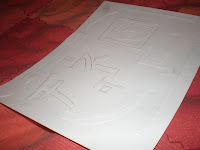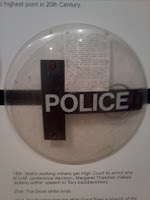As an experiment, I did some lino printing. In order to make a good lino print. I took the following steps:
Using tracing paper, I drew my design, which would be drawn on to the lino. Except, when I transfer the design on the lino sheet, I would draw it front to back, so that the design would come out the right way. Next, I would cut out the parts, I would want to be shown on the print, using a lino cutting tool and a bench hook to not cut into the tables. I made sure to change the blades, to very the marks I make, including the size of the marks. Although, I made not to cut too deep, or this would spoil the design. After this, I went on to make a lino printing, using oil-based inks and the Albion press. I then went on to use two colours on the sheet, creating a multi-coloured print.
The characteristics of the lino sheet are that it's smooth, durable, bendy, tough, flat, hard, thin and reinforced. It's advantages are that you can carve it, print it, use for reduction printing, embossing, carve it, tough, sturdy, print on to multiple other surfaces, easy to use if you're an expert, easy for big or simple designs. However, its disadvantages are that the irreversible mistakes, you can't print 3D objects, and it can be hard to carve into to texturise it. Also you can't go into detail with colours when printing, cleaning is a VERY long, long time to dry, and barrier cream has to be applied so that the oil-based ink can wash off of your skin. white spirit STINKS, it is time consuming to cut, it can be difficult to get used to, especially for beginners, and it's also difficult to carve in detail.
This was my first lino print. It didn't go as well as I would have liked it, as I didn't apply enough ink on to it. However, the picture seems to show up, which is a good thing.
This was my second lino print. I used a blend of colours on the left hand side, and another different colour on the other. This print was much better than the last one, as enough ink was applied.
Third lino print. Not enough ink was applied this time around, but it was still sufficient enough.
This is the lino sheet, which was carved into, to make this picture, used to printing. As you can see, the picture is back to front from the prints, in order to make the prints come out the way I intended.


































